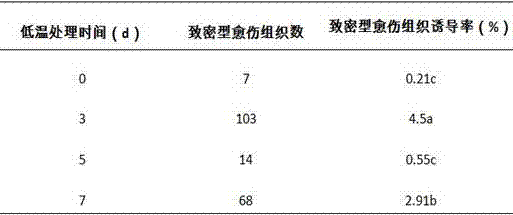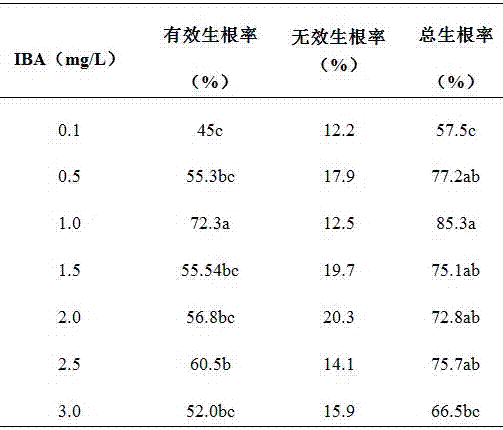Method for acquiring asparagus homozygous diploid by culturing anther
A diploid and asparagus technology, applied in horticultural methods, botanical equipment and methods, applications, etc., can solve the problems of serious somatic cell interference, low frequency of haploid pollen, low callus induction rate, etc., to achieve Promote the effect of steady development and stable traits
- Summary
- Abstract
- Description
- Claims
- Application Information
AI Technical Summary
Problems solved by technology
Method used
Image
Examples
Embodiment 1
[0032] Example 1 A method for obtaining asparagus homozygous diploid by anther culture
[0033] The main programs are as follows:
[0034] 1. Asparagus anther culture steps
[0035] 1.1 Acquisition of asparagus anthers
[0036] From 8:00 to 10:00 in the morning from April to May every year, 20 male inflorescences of different single plants were obtained from the field and marked respectively. After the male inflorescences of asparagus were retrieved, buds with a length of about 1-2mm were selected. Microscopic examination showed that, At this time, the pollen is in the mononuclear border stage.
[0037] The asparagus plant variety is 'Champion'.
[0038] 1.2 Pretreatment of asparagus anthers
[0039] Put the asparagus buds in a 4°C refrigerator for low-temperature pretreatment for 2.5-3.5 days, soak the buds in 75% alcohol solution on the ultra-clean workbench for 10s, rinse with sterile water for 3 times, and soak them in 0.2% mercuric solution for 15 seconds. min, rinse...
Embodiment 2
[0054] Example 2 Test results of other asparagus varieties
[0055] The method of obtaining asparagus homozygous diploid by using anther culture described in Example 1 was adopted, and the varieties of asparagus were changed, and Lu Asparagus No. 1, Grande, and Jinglu No. 1 were respectively used.
[0056] surface Anther callus induction rate (%)
[0057]
[0058] The above-mentioned callus is a hard and compact callus.
[0059] surface Germination rate and multiplication coefficient of different varieties
[0060]
[0061] surface Effective rooting rate of different varieties (%)
[0062]
[0063] surface Haploid, diploid, tetraploid and aneuploid status of differentiated green shoots in different varieties (%)
[0064]
[0065] surface Success rate of haploid chromosome induction in different varieties (%)
[0066]
[0067] Table 6 Results of haploid chromosome doubling in different varieties
[0068]
Embodiment 3
[0069] Example 3 Effects of different anther collection times on callus induction rate
[0070] Using the method described in Example 1, only the anthers in the step "1.1 Acquisition of Asparagus Anthers" were changed
[0071] The time of collection and the variety of asparagus were tested.
[0072] In Weifang area, the flowering period of asparagus lasted until September to October. Therefore, the anthers of different months were collected from April to September in 2010 to 2015, and the callus induction rate of anthers at different collection times was studied. The results showed that the anthers from April to May The induction rate was the highest, followed by June, and lower inoculated after July. The four varieties used in the experiment showed this regularity (Table 7).
[0073] Table 7 Induction rate of anther callus in different periods (%)
[0074]
[0075] The above-mentioned callus refers to the hard and compact callus
PUM
 Login to View More
Login to View More Abstract
Description
Claims
Application Information
 Login to View More
Login to View More - R&D
- Intellectual Property
- Life Sciences
- Materials
- Tech Scout
- Unparalleled Data Quality
- Higher Quality Content
- 60% Fewer Hallucinations
Browse by: Latest US Patents, China's latest patents, Technical Efficacy Thesaurus, Application Domain, Technology Topic, Popular Technical Reports.
© 2025 PatSnap. All rights reserved.Legal|Privacy policy|Modern Slavery Act Transparency Statement|Sitemap|About US| Contact US: help@patsnap.com



